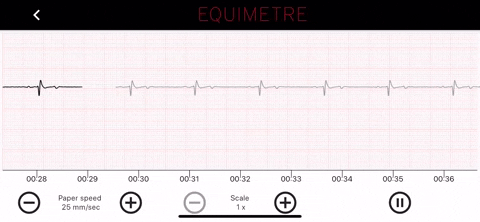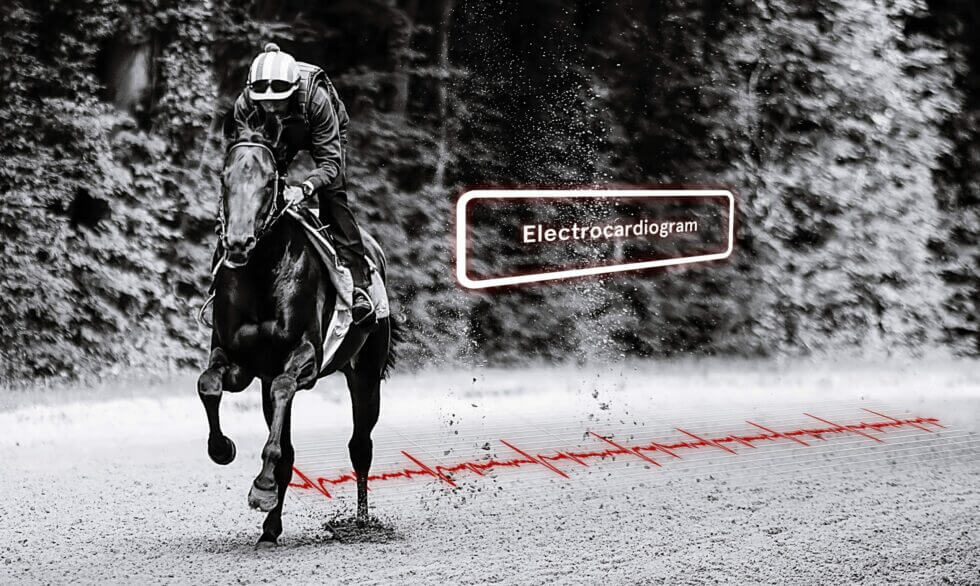Monitoring your racehorse’s training on a regular basis using a connected sensor has many advantages. It allows to assess the horse’s training level during the effort, its recovery capacity and its current fitness condition. The long-term training of a horse can change its heart activity. For example, he will be able to run at a higher speed for the same heart rate. However, these changes can lead to the development of cardiac abnormalities such as arrhythmias. An electrocardiographic monitoring of the athletic horse is necessary to prevent the physiological development of any cardiac pathologies. Collecting the ECG of the horse makes it possible to analyse a decrease in performance and to investigate a cardiac problem that could lead to an accident on the racetrack or during training.
ECG of the horse, definition & explanation
The electrocardiogram (known as ECG) is a veterinary tool that records the electrical activity of the heart. It allows to investigate and monitor the heart function of the horse by displaying the electrical activity of the heart.
The racehorse’s cardio can be strained due to the intensity of the efforts required during a race or intensive training. This is why the ECG has become essential in monitoring the health of racehorses. Prior to the arrival of the connected sensors developed in recent years, ECG was carried out in the clinic, at rest or on a treadmill. Many independent tools were required to collect all cardiac, GPS and locomotor data. Sensors such as EQUIMETRE make it possible to measure the ECG during exercise, in real conditions, at full speed.
How does the horse’s ECG work?
The analysis of the ECG allows several things:
- Detect possible heart problems
- Evaluate treatment during the follow-up of a horse
- Check that the heart is working properly
- Assess heart rhythm during general anaesthesia
- Measure heart rate variability, measurement of fitness status
How to measure the ECG of the horse ?
In order to perform an ECG, it is necessary to have a tool with electrodes and a sensor that records the measurement taken. Over time, the development of ambulatory devices has made it possible to perform ECGs in the box at rest, as well as during exercise for sensors with wireless autonomy (such as EQUIMETRE). The signal can then be stored digitally and transmitted wirelessly via BLE or 3G, allowing live viewing during exercise.
EQUIMETRE offers a major advantage on the market: it can be installed in 30s and allows to collect an ECG of medical precision at full speed. The ECG is automatically recorded at each training session. Thus, if he wishes, a trainer can ask his veterinarian to analyse an ECG remotely thanks to the mirror account functionality of the EQUIMETRE platform. This functionality allows you to work with complete peace of mind and to carry out preventive work.
Once the ECG files have been recorded, they are imported on a computer in order to be analysed using specialised software.

Live ECG from the Equimetre App
How to analyse the ECG of the horse?
The analysis of the ECG is based on the quality of the different waves measured:
- The P wave stands for the contraction (depolarisation) of the atriums.
- The PR segment represents the transmission of the electrical pulse to the ventricles.
- The QRS complex represents the contraction (depolarisation) of the ventricles.
- The T-wave illustrates the relaxation of the ventricles (repolarization)
A practical example of a horse’s ECG during effort

This horse ECG does not present any visible pathology

This horse suffers from atrial fibrillation during effort
In conclusion, it is important to monitor racehorses with an ECG as this tool allows you to work in complete safety. Carrying out an ECG frequently makes it possible to detect possible pathologies that may develop during training. The emergence of connected sensors facilitates communication between trainers and their veterinarian, allowing the best possible monitoring of the athletic horse.
Keywords: ECG, cardiac pathologies, heart rate, cardio, electrocardiogram, heart function


